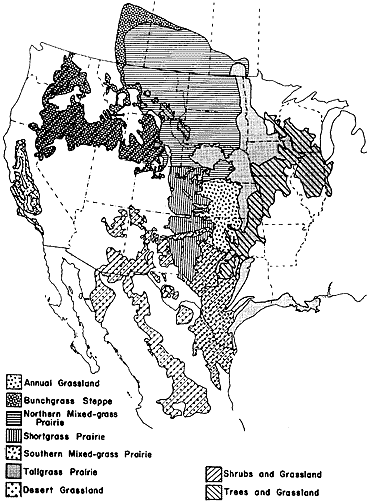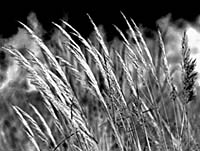
FO-03238
1995
![]()

FO-03238
1995
![]()
This bulletin describes three typical prairie communities: wet, mesic, and dry, and the plants found in these communities. Characteristics of each community are provided along with typical plants found in each site. This information should be useful to professional designers, teachers, landscape architects as well as amateur gardeners who have an interest in native plants and their landscape use.
Although the extensive table “Characteristics of Prairie Plants” lists 158 grasses and forbs, it is not offered as a comprehensive or exhaustive compilation of all native plants found in the area. However, an effort has been made to cover the more significant species occurring across the North Central region of the United States.
People are not always aware of protected and/or rare species. Each state has its own regulations as well as lists of threatened and endangered plants. Some states may require licensing or registration with the Department of Natural Resources (DNR) or other agency for collection and/or propagation of native plants. The by-word of all who are interested in native plants should be “Check before you collect.” Check with your local county extension educator, the DNR, the Department of Agriculture, private landowners or the appropriate state agency if public lands are involved. In all cases, respect for the environment and other people's property is important.
Planting and maintenance of a prairie is beyond the scope of this publication. Consult the reference list for further information, and for references on botanical names and native plant organizations and horticultural societies.
Prior to European settlement, vast grasslands or prairies existed throughout the central United States (Map 1). Today, very little of the original prairie exists due to commercial agriculture, development of communities, towns, roads, etc. Some estimates are that the shortgrass prairie and the mixed-grass prairie cover about 1/5 and ¼, respectively, of the areas they once did. Of the tallgrass prairie, only about 1% remains in the United States today. These three grassland communities are based on rainfall. The higher annual precipitation in the east resulted in the tallgrass prairie and the decreased moisture westward resulted in shortgrass.
Within the major types of prairies (short, mixed, and tallgrass) exist communities of plants that thrive on specific sites. Three of the most common sites—wet, mesic, and dry—are discussed in this bulletin. Species composition of these three habitats changes as one goes from east (tallgrass) to west (shortgrass). A wet habitat in the tallgrass prairie is floristically quite different from a wet habitat in the shortgrass prairie. This publication generally applies to the tallgrass and mixed-grass regions. Many plants are quite restricted in their habitat preferences and may be limited to one habitat. for example, Aster simplex, panicled aster, prefers only wet sites, while other species, like Schizachyrium scoparium, little bluestem, and Oenothera pilosella, prairie sundrops, are more tolerant and may occur in all three communities.
 |
Roy Robison received his B.S. from the University of Minnesota and is president of Landscape Alternatives, Inc., a nursery that propagates and sells native wildflowers and grasses.
Donald B. White is a professor in the Department of Horticultural Science, University of Minnesota. He teaches courses in turfgrass science and is interested in native prairie establishment.
Mary H. Meyer is an assistant professor in the Department of Horticultural Science, University of Minnesota, and conducts research on native and ornamental grasses.

![]()
North Central Regional Extension Publications are subject to peer review and prepared as a part of the Cooperative Extension activities of the thirteen land-grant universities of the 12 North Central States, in cooperation with the Extension Service—U.S. Department of Agriculture, Washington, D.C. The following states cooperated in making this publication available.
INDIANA
Purdue University
1143 Ag Admin Bldg
West Lafayette IN 47907-1143
Internet: southard@ecn.purdue.edu
IOWA
Iowa State University
Ames IA 50011
Internet: x1hamilt@exnet.iastate.edu
MINNESOTA*
University of Minnesota
20 Coffey Hall
1420 Eckles Ave.
St. Paul MN 55108-6069
Internet: jean@dc.mes.umn.edu
MISSOURI
Lincoln University
900 Moreau Drive
Jefferson City MO 65101
Internet: dfasmedia@lua6.lu.edu
University of Missouri
1-98 Agriculture Bldg
Columbia MO 65211
Internet: extret@umcvmb.missouri.edu
NEBRASKA
University of Nebraska
105 Ag Communications Bldg
Lincoln NE 68583-0918
Internet: agcm002@unlvm.unl.edu
OHIO
Ohio State University
216 Kottman Hall
Columbus OH 43210
Internet: scardena@agvax2.ag.ohio-state.edu
*Publishing state
For copies of this and other North Central Regional Extension Publications, write to: Publications Office, Cooperative Extension Service, in care of the University listed above for your state. If they do not have copies or your state is not listed above, contact the publishing state as specified.
![]()
Photographs by Don Breneman
Graphic Design by Tammy Nelson
Produced by Communication and Educational Technology Services, University of Minnesota Extension Service.
In accordance with the Americans with Disabilities Act, this material is available in alternative formats upon request. Please contact your University of Minnesota Extension Service office or the Distribution Center at (800) 876-8636.
The University of Minnesota Extension Service is committed to the policy that all persons shall have equal access to its programs, facilities, and employment without regard to race, color, creed, religion, national origin, sex, age, marital status, disability, public assistance status, veteran status, or sexual orientation.